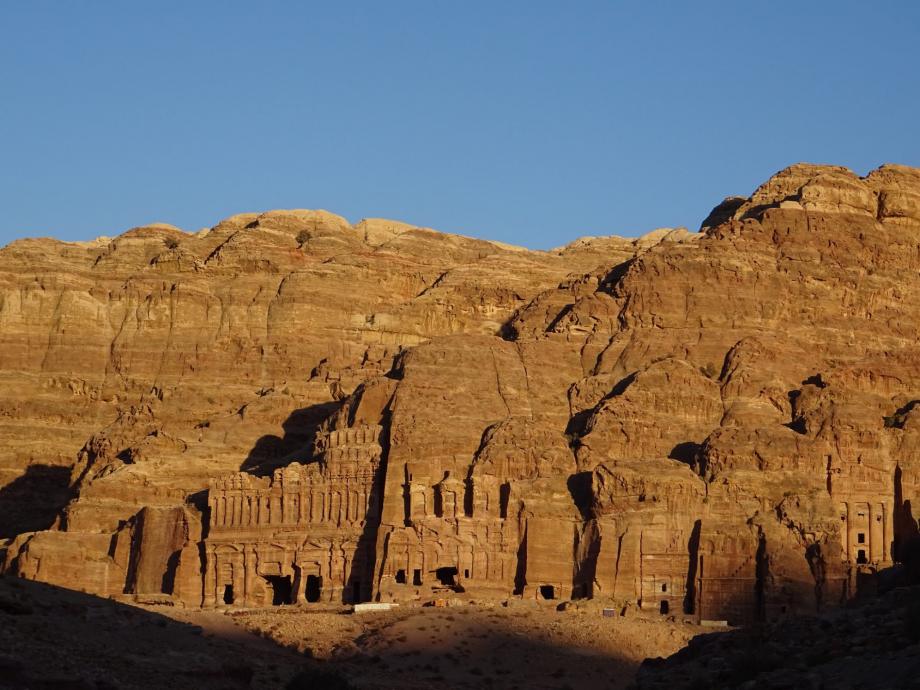I already wrote a bit about our holiday in Jordan last week. Today, we fly back home, my head is full with pictures and impressions. I need to sort out and reflect on what I have seen and experienced.
From the Dead Sea we drove through the Dana National Park to Petra. Already on the way to Petra I felt like I was on another planet, I had never seen such rock formations on the edge of a desert . Petra, the city carved out of rocks is very impressive. As a good tourist I had read about it before, but to see this about 2 300 year old city is something else. Until Petra, I had never heard of the Nabateans, Arabian desert people. The Nabateans originally lived in today’s Saudi Arabia and controlled the local caravan trade. About 2300 years ago, they extended their sphere of influence to the northwest of the Arabian peninsula along the caravan routes and settled down in Raqmu, today known as Petra. This city became their center of power. The place was well-chosen: six caravan routes crossed here and there was water from the surrounding mountains. Not only were the Nabateans intelligent builders, they carved a city out from the rocks for about 40 000 people, supplied water through a advanced irrigation system (and also drained the sewage), buried their kings there and built temples, churches and worship places. They also provided hospitality services to the traders who passed through the city by taking care of humans and animals. People could worship in one of the many temples, churches and chapels, representing the various religions of this time.
To this day, this is at least my impression, this hospitality and tolerance is something special to Jordanians. They are friendly and tolerant of strangers, it is easy to get in touch and after a few minutes you find yourself in lively discussions about God and the world (in the truest sense of the words).
Jordan has little mineral resources and has always created an income by collecting customs duties and taxes from trade routes. That is still the case today: the entrance fees to the national parks and cultural monuments are quite steep. One day Petra (from sunrise to sunset) costs 66 € per adult. In Wadi Rum, where we went afterwards, you pay an entrance to the National Park (which flows into the state treasury) and then you have the choice between different tours to discover the park: on foot, by camel or by jeep. You pay per hour and mode of transport. These revenues benefits the resident Bedouins. In theory, one could walk on foot to explore the Wadi, as Lawrence of Arabia used to do. I think that’s an option for a few people only.
Anyway, it’s definitely an unforgettable experience and if you want to see all these places you just have to pay.
After exploring Petra and Wadi Rum, we needed a seaside retreat, so we rented a room at the Read Sea Dive Center in Aqaba. This is a small, locally run hotel with a diving school, because this area still has coral reefs and a great variety of sea creatures to see. We did no go for a dive but relaxed for two days on the beach of Tala Bay, South of Aqaba.
Tala Bay is a resort town, much like Barcarès or Leucate Plage, but a way more luxury. Many foreigners and certainly a few wealthy Jordanians, Iraqis, Syrians, etc. have a summer residence there.
Tala Bay started in 2001 and meanwhile, gated communities are developing along the entire coastline of the Gulf and they have some advantages to offer: investments are tax-free or are only taxed at 5%, nobody asks where the money comes from, everything is very discreet and legally secured.
Here, too, the mentality of the Jordanians is visible: open to all, good service, beautiful location, no stress, for a corresponding fee.
This mentality is also based on the admission of millions of refugees. Supported by international aid organizations and states with financial contributions these people are more or less integrated, get the citizenship and thus a right to education and work. However, Jordan also reached its limits. There have been several major refugees flows since 1948 and today more than 50% of the population is made up of former refugees, primarily Palestinians, but also people from other Arab countries.
It seems to me that this is part of a deal: Jordan receives the refugees from the crisis areas of the Arabian Peninsula, gets financial support and, more importantly, has no trouble with Israel and is not on the list of states to be democratized.
In Petra, I listened to a conversation between a tourist and a local tourist guide:
Tourist: Who owns Jordan?
Guide: Well, we are having a lot of tribes, they are all coming and going and live together.
Tourist: So they all own Jordan?
Guide: hmm, no, America owns Jordan.
Anyway, this holiday was very interesting, exciting and also relaxing and I could start the next journey immediately 😉

